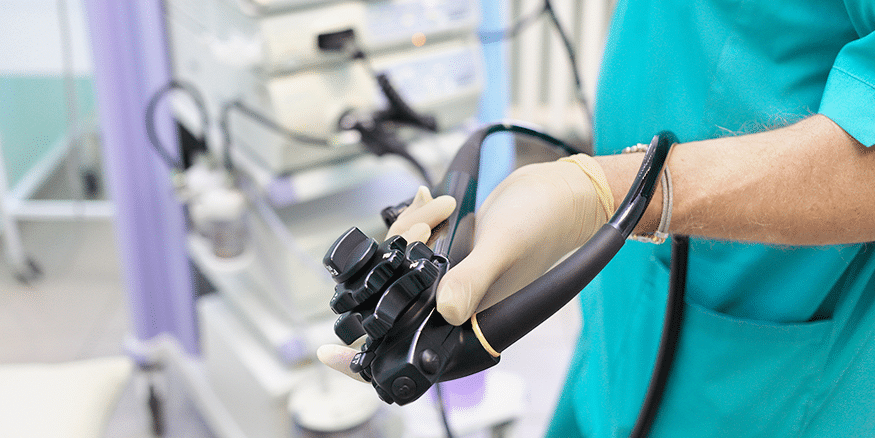
Scoping
Your doctor may have explained that you require a special examination with a scope. This examination gives the doctor a close-up view of the inside of your digestive tract. If necessary, biopsies are easily taken during the procedure. The scope has a flexible tube that contains special fibres that carry a picture image from the tip of the viewing lens, which goes inside your body, to a TV screen. The image can be viewed, recorded, and pictures can be printed. There is a miniature washing system to keep the doctor’s viewing area clear throughout the examination. This test can take one of two forms.
Gastroscopy
A gastroscopy (gas-tros-ko-pee) allows the doctor to look at your upper digestive system; your esophagus, stomach, and duodenum.
The examination is done using an instrument called a gastroscope. This is a narrow, flexible and very smooth tube, about as thick as a ball-point pen. It is passed through the mouth, to the back of the throat. Unlike X-rays, which take “pictures” of these areas, the gastroscope lets the doctor see the internal surfaces of the digestive tract directly. Although X-rays are a useful diagnostic tool, the scope allows greater close-up visualization and can provide different information than an X-ray.
There is specific preparation that you must comply with before this test is done. Preparation includes avoidance of food and drink for a period of time prior to the examination. If you are booked for a gastroscopy, you will be given specific instructions
When you arrive at the clinic for a gastroscopy, your throat will be sprayed with a topical anesthetic, to numb your throat. This is similar to medication the dentist uses to freeze your mouth. It helps to keep you from gagging during the test. Dentures or partial plates need to be removed before spraying your throat.
You will be asked to lie on your left side. You may be given an injection to help you relax and make swallowing easier. A plastic mouth guard is placed between your teeth to protect the tube.
The tip of the tube is inserted through the mouth guard and gently slid to the back of your throat. You will be asked to swallow to help the doctor guide the tip down your esophagus. The tube passes down your “food pipe”, not your “air pipe” and it does not block your breathing. Air is introduced into the tube and this allows the doctor to see parts of your digestive tract that may be hidden. You may feel full or bloated during this part of the examination, but the feeling will go away when the air is removed through the tube.
While the doctor is looking inside your digestive tract, a biopsy can be taken. (Patients do not feel the biopsy being taken.)
A gastroscopy takes 10 – 15 minutes to complete. Instructions to follow after the test will vary depending on whether or not you have been given relaxation medication. Usually, you will require someone to escort you from the testing clinic.
Colonoscopy
A colonoscopy (co-lon-os-ko-pee) is a test that lets the doctor look at the lining of the rectum and the large bowel (colon). This examination is ordered when a doctor suspects something is wrong with your bowel. Bleeding and diarrhea are the most common reasons. The test is done using a small, smooth flexible tube, that is a little thicker than a ball-point pen.
The results will show exactly what is wrong so you can be helped effectively. In certain cases, treatment is possible during the colonoscopy, thereby avoiding surgery. Polyps or other abnormalities that are found in the bowel during the test may be removed through the tube.
A significant amount of preparation is necessary to ensure that the bowel is empty of waste material before the test begins. If you are booked for a colonoscopy, you will be given specific instructions.
Before the test, intravenous fluids (IV) may be started. Just before the test begins, you will be given some medication through the IV to help you relax.
While you are lying on your left side, a tube is gently inserted into the rectum and gently maneuvered along inside the large bowel. A small amount of air is passed through the tube so that parts of the bowel that are usually hidden may be seen. You may feel some fullness in your bowels and may experience the sensation of needing to move your bowels. This feeling is caused by the air and will quickly disappear when the air is removed through the tube.
Tiny pieces of tissue (biopsies) may be removed through the tube for study in the laboratory. You will not feel anything if biopsies are taken.
A colonoscopy takes 15 – 45 minutes to complete. Following this test you may feel drowsy and sleep for a short time. Your IV will be removed and fluids will be provided.
Any feelings of fullness will pass as you move around. Instructions to follow after the test will vary depending on whether or not you have been given relaxation medication. You will require someone to escort you from the testing clinic.
Caution
If you have been given a sedative for either of these procedures, consult your doctor for advice on how long you should wait before:
- driving
- using machinery
- using public transport
- going back to work
- signing legal documents
